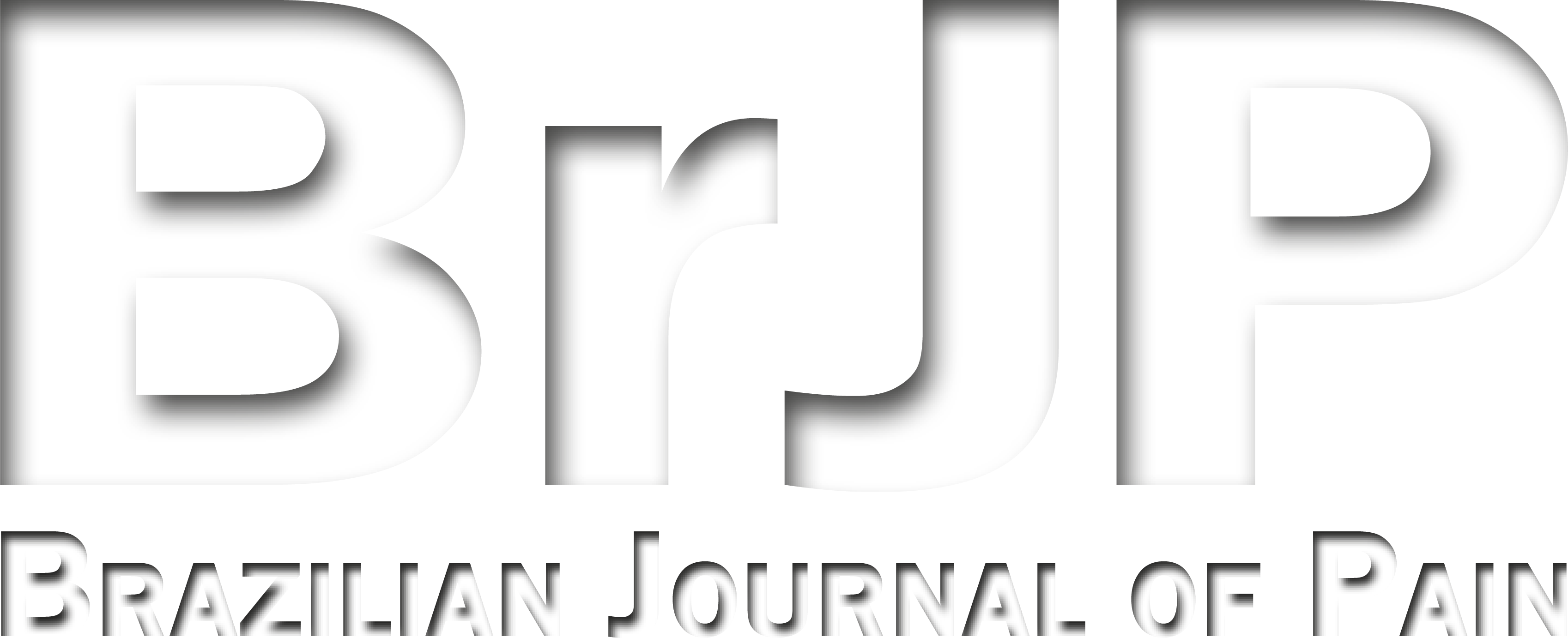Knowledge and use of Integrative and Complementary Health Practices by patients with orofacial pain
Conhecimento e uso das Práticas Integrativas e Complementares em Saúde por pacientes com dor orofacial
Keila Esterlina Chagas; Clarice do Vale Araújo Melo; Isabela Rodrigues Rocha; Camila Megale Almeida-Leite; Janice Simpson de Paula
Abstract
Keywords
Resumo
Palavras-chave
References
Turner JA, Franklin G, Fulton-Kehoe D, Egan K, Wickizer TM, Lymp JF. Prediction of chronic disability in work-related musculoskeletal disorders a prospective, population-based study. BMC Musculoskelet Disord. 2004;5:14.
Gureje O, Von Korff M, Simon GE, Gater R. Persistent pain and well-being a World Health Organization Study in Primary Care. JAMA. 1998;280(2):147-51.
Fayaz A, Croft P, Langford RM, Donaldson LJ, Jones GT. Prevalence of chronic pain in the UK: a systematic review and meta-analysis of population studies. BMJ Open. 2016;20(6).
Magalhães BG, de Sousa ST, de Mello VV, da-Silva Barbosa AC, de-Assis-Morais MP, Barbosa-Vasconcelos MM. Risk factors for temporomandibular disorder: binary logistic regression analysis. Med Oral Patol Oral Cir Bucal. 2014;19(3):e232-6.
Edwards RR, Dworkin RH, Sullivan MD, Turk DC, Wasan AD. The role of psychosocial processes in the development and maintenance of chronic pain. J Pain. 2016;17(9 Suppl):T70-92.
Silva LB, Lima IC, Bastos RA. Terapias complementares e integrativas conhecimento e utilizações pelos docentes do curso de enfermagem de uma instituição pública. Rev Saúde Col UEFS. 2015;5(1):40-5.
Li X, Wang R, Xing X, Shi X, Tian J, Zhang J. Acupuncture for myofascial pain syndrome a network meta-analysis of 33 randomized controlled trials. Pain Physician. 2017;20(6):E883-902.
Chen J, Huang J, Li JV, Lv Y, He Y, Zheng Q. The characteristics of TCM clinical trials a systematic review of clinicaltrials.gov. Evid Based Complement Alternat Med. 2017;2017:9461415.
Zotelli VL, Grillo CM, Gil ML, Wada RS, Sato JE, da Luz Rosário de Sousa M. Acupuncture effect on pain, mouth opening limitation and on the energy meridians in patients with temporomandibular dysfunction a randomized controlled trial. J Acupunct Meridian Stud. 2017;10(5):351-9.
Departamento de Atenção Básica. Portaria 971 - Política Nacional de Práticas Integrativas e Complementares (PNPIC) no Sistema Único de Saúde. 2006.
Dhanani NM, Caruso TJ, Carinci AJ. Complementary and alternative medicine for pain an evidence-based review. Curr Pain Headache Rep. 2011;15(1):39-46.
Münstedt K, Harren H, von Georgi R, Hackethal A. Complementary and alternative medicine comparison of current knowledge, attitudes and interest among German medical students and doctors. Evid Based Complement Alternat Med. 2011;2011:790951.
Armstrong AR, Thiébaut SP, Brown LJ, Nepal B. Australian adults use complementary and alternative medicine in the treatment of chronic illness a national study. Aust N Z J Public Health. 2011;35(4):384-90.
Murthy V, Sibbritt D, Broom A, Kirby E, Frawley J, Refshauge KM. Back pain sufferers' attitudes toward consultations with CAM practitioners and self- prescribed CAM products a study of a nationally representative sample of 1310 Australian women aged 60-65 years. Complement Ther Med. 2015;23(6):782-8.
Zhang Y, Leach MJ, Hall H, Sundberg T, Ward L, Sibbritt D. Differences between male and female consumers of complementary and alternative medicine in a National US Population a secondary analysis of 2012 NIHS Data. Evid Based Complement Alternat Med. 2015;2015:413173.
Fernández-de-las-Penas C, Svensson P. Myofascial temporomandibular disorder. Curr Rheumatol Rev. 2016;12(1):40-54.
Wu JY, Zhang C, Xu YP, Yu YY, Peng L, Leng WD. Acupuncture therapy in the management of the clinical outcomes for temporomandibular disorders a PRISMA-compliance meta-analysis. Medicine (Baltimore). 2017;96(9).
Gonçalo CS, Mialhe FL, Vilalba JP, Barros NF. O ensino das práticas alternativas e complementares na graduação em Odontologia. O ensino das práticas integrativas e complementares: experiências e percepções. 2011.
Poveda Roda R, Bagan JV, Días Fernández JM, Hernández Bazán S, Jiménez Soriano Y. Review of temporomandibular joint pathology Part I: classification, epidemiology and risk factors. Med Oral Patol Oral Cir Bucal. 2007;12(4):E292-8.
Tosato JP, Caria PHF. Prevalência de DTM em diferentes faixas etárias. RGO. 2006;54(3):211-24.
Silveira AM, Feltrin PP, Zanetti RV, Mautoni MC. Prevalence of patients harboring temporomandibular disorders in an otorhinolaryngology department. Braz J Otorhinolaryngol. 2007;73(4):528-32.
Donnarumma MDC, Muzilli CA, Ferreira C, Nemr K. Disfunções temporomandibulares sinais, sintomas e abordagem multidisciplinar. Rev CEFAC. 2010;12(5):788-94.
Venancio RA, Camparis CM. Estudo da relação entre fatores psicossociais e desordens temporomandibulares. Rev Bras Odontol. 2002;59(3):152-4.
Oliveira NCM, Machado NA de G, Siqueira AFC, Simamoto-Junior PC, Silva MR, Fernandes-Neto AJ. Programa de acolhimento, tratamento e controle de pacientes com disfunção temporomandibular e dor orofacial experiência de seis anos. Revista Em Extensão. 2012;11(1):36-43.
Dacal MPO, Silva IS. Impactos das práticas integrativas e complementares na saúde de pacientes crônicos. Saúde Debate. 2018;42(118):724-35.
Mendes DS, Moraes FS, Lima GO, Silva PR, Cunha TA, Crossetti MGO. Benefícios das Práticas Integrativas e Complementares no cuidado de enfermagem. J Health NPEPS. 2019;4(1):302-18.
Otani MAP, Barros NF. A medicina Integrativa e a construção de um novo modelo de saúde. Ciênc Saúde Coletiva. 2011;16(3):1801-11.
Cazarin G, Martins JG, de Sousa MM, Barcellos APM. Monitoramento das Práticas Integrativas e Complementares em Minas Gerais a utilização de um instrumento de apoio aos sistemas de informação. J Manag Prim Health Care. 2017;8(2):278-89.
Submitted date:
04/03/2020
Accepted date:
12/17/2020


